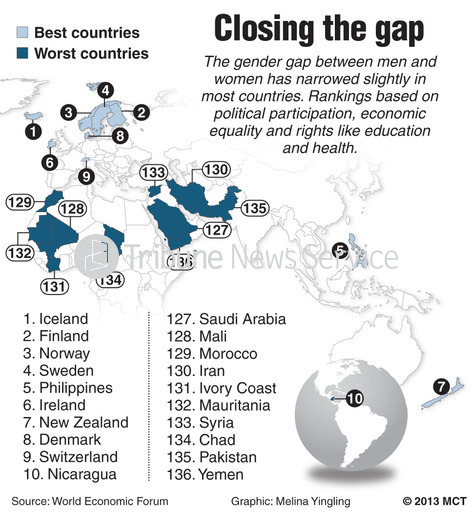Fighting for rights globally

The graphic shows the 10 best and worst ranked countries in 2013. The rankings have stayed almost the same during 2014. Many countries in Africa and the Middle East have very few rights for women. Child marriages, domestic violence, and rape often occur with little to no repercussions.
February 1, 2015
In the United States, the days when women were not allowed to vote or receive an equal education are far behind us. The future for gender equality is improving step-by-step. However, in many countries, women are still not allowed basic human rights.
According to the World Economic Forum (WEF)’s 2014 Gender Gap Report, the United States ranks 20th, out of more than 130 countries. The country of Yemen claims the lowest spot; the gap between literacy, economic participation, and physical protection of men and women is huge.
When women do not receive an equal education starting from a young age, this affects their pay in the future, because they are less likely to receive a good job.
According to an article on Marie Claire in Yemen,“the pay gap is astronomical, with women making just 30 percent of what men do.”
Also, in court, a woman’s testimony is not taken seriously; she is only considered a “half witness.” A man must back up the story in order for it to be considered.
In places such as Morocco and Saudi Arabia, victims of rape or domestic violence can be charged with the crime of “leaving the house unaccompanied” or “being alone with an unrelated man” Instead of the abuser being charged, the victims, often women, are the ones at fault and blamed for the situation.
Child marriage is another big issue in countries such as India, Yemen, Bangladesh, and Niger. Niger has the highest percentage of child marriages in the world, followed by Chad, Malawi, and Bangladesh. One in three girls are married off before they turn 15, with some as young as seven.
This denies them having a hand in their own future and impacts their physical and mental health in a big way. After marriages, pregnancy soon follows with even more health concerns.
According to an article on PBS, “Girls younger than 15 are five times more likely to die during child birth or pregnancy than older women. Pregnancy-related deaths are the leading cause of mortality for girls aged 15 to 19 worldwide.”
On the opposite end of the spectrum, the top five countries for gender equality are Iceland, Finland, Norway, Sweden, and Denmark respectively. Iceland topped out with an overall score of 0.859 (where 0 is inequality, and 1 is equality). Iceland has been ranked in the top 5 in Gender Gap Index since 2009.
According to an article on huffingtonpost.com, the Nordic countries that are ranked the highest have “high female labor force participation; salary gaps between women and men among the lowest in the world, although not non-existent.”






